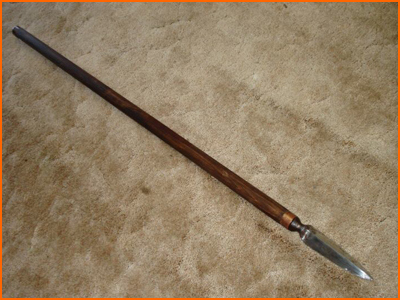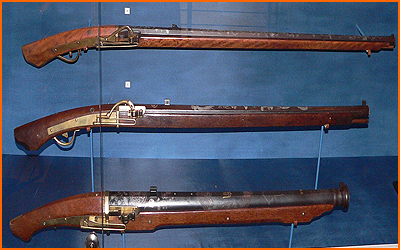
Katana

The samurai used various weapons, but the katana is the weapon that is synonymous with samurai. Bushido teaches that the katana is the samurai's soul and sometimes a samurai is pictured as entirely dependent on the katana for fighting. They believe that the katana was so precious that they often gave them names and considered them as part of the living. However the use of swords did not become common in battle until the Kamakura period , where the tachi and uchigatana (the predecessor to the katana) became prevalent. The katana itself did not become the primary weapon until the Edo period.
Tantō

The Tantō was a small dagger sometimes worn with or instead of the Wakizashi in a daisho. The tanto or the wakizashi was used to commit seppuku, a ritualized suicide through disembowelment. Tantō are generally forged in hira-zukuri, meaning that their sides have no ridge line and are nearly flat, unlike the shinogi-zukuri structure of a katana. Some tantō have particularly thick cross-sections for armor-piercing duty, and are called yoroidoshi. Tantō were mostly carried by samurai as commoners did not generally carry them. Women sometimes carried a small tantō called a kaiken in their obi primarily for self defense. It was sometimes worn as the shōtō in place of a wakizashi in a daisho, especially on the battlefield. Before the 16th century, it was common for a samurai to carry a tachi and a tantō as opposed to a katana and a wakizashi. Tantō with blunt wooden or blunt plastic blades exist and are used to practice martial arts involving the use of a tantō safely.
Yumi

The samurai stressed skill with the yumi (longbow), reflected in the art of kyujutsu (lit. the skill of the bow). The bow would remain a critical component of the Japanese military even with the introduction of firearms during the Sengoku Jidai period. The yumi, an asymmetric composite bow made from bamboo, wood, rattan and leather, was not as powerful as the Eurasian reflex composite bow, having an effective range of 50 meters (about 164 feet) or 100 meters ([328 feet]) if accuracy was not an issue. On foot, it was usually used behind a tedate, a large and mobile bamboo wall, but could also be used from horseback because of its asymmetric shape. The practice of shooting from horseback became a Shinto ceremony of Yabusame.
Yari

In the 15th century, the yari (spear) also became a popular weapon. It displaced the naginata from the battlefield as personal bravery became less of a factor and battles became more organized around massed, inexpensive foot troops (ashigaru). A charge, mounted or dismounted, was also more effective when using a spear than a sword and it offered better than even odds against a samurai using a sword. In the Battle of Shizugatake where Shibata Katsuie was defeated by Toyotomi Hideyoshi, then known as Hashiba Hideyoshi, the Seven Spearmen of Shizugatake played a crucial role in the victory.
Teppo / Arquebus

The later half of the 16th century saw the introduction of the teppo or arquebus in Japan through Portuguese trade, enabling warlords to raise effective armies from masses of peasants. The new weapons were highly controversial. Their ease of use and deadly effectiveness was perceived by many samurai as a dishonorable affront to Bushido tradition. Oda Nobunaga made deadly use of the teppo at the Battle of Nagashino in 1575, leading to the end of the Takeda clan.